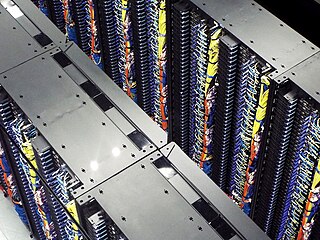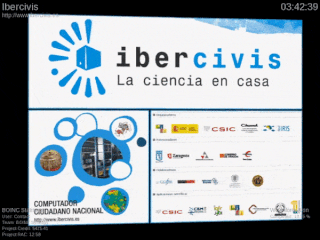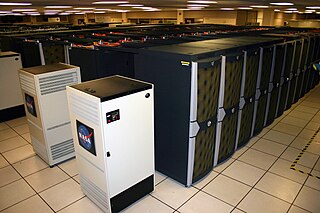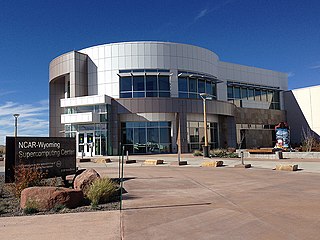
A supercomputer is a type of computer with a high level of performance as compared to a general-purpose computer. The performance of a supercomputer is commonly measured in floating-point operations per second (FLOPS) instead of million instructions per second (MIPS). Since 2022, supercomputers have existed which can perform over 1018 FLOPS, so called exascale supercomputers. For comparison, a desktop computer has performance in the range of hundreds of gigaFLOPS (1011) to tens of teraFLOPS (1013). Since November 2017, all of the world's fastest 500 supercomputers run on Linux-based operating systems. Additional research is being conducted in the United States, the European Union, Taiwan, Japan, and China to build faster, more powerful and technologically superior exascale supercomputers.

Blue Gene was an IBM project aimed at designing supercomputers that can reach operating speeds in the petaFLOPS (PFLOPS) range, with relatively low power consumption.

High-performance computing (HPC) uses supercomputers and computer clusters to solve advanced computation problems.

Forschungszentrum Jülich (FZJ) is a German national research institution that pursues interdisciplinary research in the fields of energy, information, and bioeconomy. It operates a broad range of research infrastructures like supercomputers, an atmospheric simulation chamber, electron microscopes, a particle accelerator, cleanrooms for nanotechnology, among other things. Current research priorities include the structural change in the Rhineland lignite-mining region, hydrogen, and quantum technologies. As a member of the Helmholtz Association with roughly 6,800 employees in ten institutes and 80 subinstitutes, Jülich is one of the largest research institutions in Europe.

MareNostrum is the main supercomputer in the Barcelona Supercomputing Center. It is the most powerful supercomputer in Spain, one of thirteen supercomputers in the Spanish Supercomputing Network and one of the seven supercomputers of the European infrastructure PRACE.

EPCC, formerly the Edinburgh Parallel Computing Centre, is a supercomputing centre based at the University of Edinburgh. Since its foundation in 1990, its stated mission has been to accelerate the effective exploitation of novel computing throughout industry, academia and commerce.
The Pittsburgh Supercomputing Center (PSC) is a high performance computing and networking center founded in 1986 and one of the original five NSF Supercomputing Centers. PSC is a joint effort of Carnegie Mellon University and the University of Pittsburgh in Pittsburgh, Pennsylvania, United States.

The National Energy Research Scientific Computing Center (NERSC), is a high-performance computing (supercomputer) research facility that was founded in 1974. The National User Facility is operated by Lawrence Berkeley National Laboratory for the United States Department of Energy Office of Science.

The Spanish Supercomputing Network (RES) is a distributed infrastructure involving the interconnexion of 12 supercomputers which work together to offer High Performance Computing resources to the scientific community. It is coordinated by the Barcelona Supercomputing Center (BSC).

Finisterrae was the 100th supercomputer in Top500 ranking in November 2007. Running at 12.97 teraFLOPS, it would rank at position 258 on the list as of June 2008. It is also the third most powerful supercomputer in Spain. It was located in Galicia.

Ibercivis was a volunteer computing platform which allows internet users to participate in scientific research by donating unused computer cycles to run scientific simulations and other tasks. The original project, which became operational in 2008, was a scientific collaboration between the Portuguese and Spanish governments, but it is open to the general public and scientific community, both within and beyond the Iberian Peninsula. The project's name is a portmanteau of Iberia and the Latin word civis, meaning 'citizen'.

Pleiades is a petascale supercomputer housed at the NASA Advanced Supercomputing (NAS) facility at NASA's Ames Research Center located at Moffett Field near Mountain View, California. It is maintained by NASA and partners Hewlett Packard Enterprise and Intel.

Distributed European Infrastructure for Supercomputing Applications (DEISA) was a consortium of major national supercomputing centres in Europe. Initiated in 2002, it became a European Union funded supercomputer project. The consortium of eleven national supercomputing centres from seven European countries promoted pan-European research on European high-performance computing systems by creating a European collaborative environment in the area of supercomputing.
The National Center for Computational Sciences (NCCS) is a United States Department of Energy (DOE) Leadership Computing Facility that houses the Oak Ridge Leadership Computing Facility (OLCF), a DOE Office of Science User Facility charged with helping researchers solve challenging scientific problems of global interest with a combination of leading high-performance computing (HPC) resources and international expertise in scientific computing.
New York Blue is an 18 rack Blue Gene/L and a 2 rack Blue Gene/P massively parallel supercomputer based on the IBM system-on-chip technology. It is in the New York Center for Computational Sciences (NYCCS). The supercomputer is owned by Stony Brook University and is located at Brookhaven National Laboratory in Upton, Long Island, New York. The funds for this machine were provided by the New York state, with the leadership of the NYS Assembly. It began operating on July 15, 2007, when it was the fifth most powerful supercomputer dedicated to general research. According to Stony Brook provost Robert McGrath, it would also rank within the top 10 when including supercomputers available solely for military research. The renovation of the laboratory space holding the machine was supported by the State of New York and the U.S. DOE fund. As of June 2010, the Blue Gene/L was ranked 67th in the top 500 supercomputing rankings. Together with the Computational Center for Nanotechnology Innovations at Rensselaer Polytechnic Institute, New York Blue provides the New York state with more computing power available for general research than any state in the nation.

Several centers for supercomputing exist across Europe, and distributed access to them is coordinated by European initiatives to facilitate high-performance computing. One such initiative, the HPC Europa project, fits within the Distributed European Infrastructure for Supercomputing Applications (DEISA), which was formed in 2002 as a consortium of eleven supercomputing centers from seven European countries. Operating within the CORDIS framework, HPC Europa aims to provide access to supercomputers across Europe.

Yellowstone was the inaugural supercomputer at the NCAR-Wyoming Supercomputing Center (NWSC) in Cheyenne, Wyoming. It was installed, tested, and readied for production in the summer of 2012. The Yellowstone supercomputing cluster was decommissioned on December 31, 2017, being replaced by its successor Cheyenne.

The high performance supercomputing program started in mid-to-late 1980s in Pakistan. Supercomputing is a recent area of Computer science in which Pakistan has made progress, driven in part by the growth of the information technology age in the country. Developing on the ingenious supercomputer program started in 1980s when the deployment of the Cray supercomputers was initially denied.

The NCAR-Wyoming Supercomputing Center (NWSC) is a high-performance computing (HPC) and data archival facility located in Cheyenne, Wyoming, that provides advanced computing services to researchers in the Earth system sciences.

Enzo Marinari is an Italian theoretical and computational physicist. He has contributed to introducing several new algorithms in computational physics, such as Parallel Tempering, the SU(N) updating method and Constraint Allocation Flux Balance Analysis (CAFBA). He is a professor at the Physics Department of the Sapienza University of Rome.


















